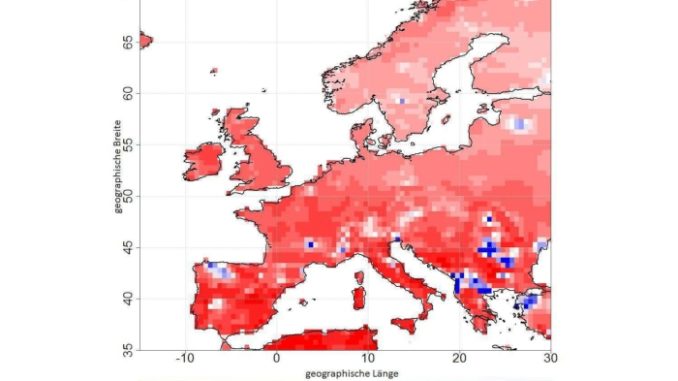
Views: 87
The KIT is developing a new system with cooperating partners that will allow more accurate statements on climate development over the next ten years.
The climate is changing due to warming: droughts, floods and extreme weather events are affecting the (rural) economy and society. An essential prerequisite for improved and concrete adaptability of industry and society to future climate are reliable statements about medium-term climate developments – especially for individual regions. A corresponding model, which can make more accurate regional climate forecasts for Europe over a period of up to ten years, was developed by the Karlsruhe Institute of Technology (KIT) with partners in the MiKlip project.
What will the weather be like tomorrow or the next two weeks? Forecasts of short-term changes in atmosphere to seasonal forecasts are already calculated regularly. By comparison, the decade’s forecasts indicate climate trends for a medium-term period of up to ten years. In the MiKlip (Medium Term Climate Forecast) project, the KIT, together with the German Meteorological Service (DWD), the Max Planck Institute for Meteorology in Hamburg (MPI) and other universities, has developed a forecasting system that provides resolution climate forecasts. specifically for areas in the 25 kilometer size range calculated.
COSMO-CLM’s global climate forecast is based on the MPI ECHAM global climate model and differs from long-term projections such as the IPCC Fifth Assessment Report in that it incorporates the “memories” of various components of the climate system as Initial conditions: Atmosphere, ocean, land or ice mass react at different speeds to external influences such as carbon dioxide or temperature. For example, the atmosphere stores heat for only a few days, sea ice stores it for one to two years, and the ocean for up to 100 years.
The COSMO-CLM model describes the state of the atmosphere interacting with the earth’s surface in Europe. A complex computer program divides the earth’s surface into thousands of grid boxes and uses mathematical equations and physical laws to calculate, for example, the temporal evolution of the surface temperature of each box. COSMO-CLM can provide forecasts – for example for Europe – with a 25 km mesh with refined spatial and temporal resolution and derive user-relevant climate information. Regional models are subject to the same physical principles and basic equations as global models, but they calculate clouds, wind flow and precipitation in much more detail and additionally use more accurate land surface data as a database.
In studies of earlier periods, climatologists have been able to test the predictions of this system and find useful predictions for Europe, especially for measurements that characterize warming. Forecasts based on current data suggest that Europe’s average temperatures over the next ten years will be more than one degree Celsius above the 1980-2010 average, the warmest period since the beginning of systematic measurements. At the same time, the temperature anomaly in Europe is increasing from west to east, with the largest warming in southeastern Europe. Such predictions about developments in the climate system are possible only if the initial conditions and the physical laws governing the processes of nature are known in detail.
COSMO-CLIM is part of the MiKlip project, funded by the Federal Ministry of Education and Research (BMBF). Project MiKlip climate forecasts for the period 2019-2028 and research publications are published here: www.fona-miklip.de/decadal-forecast/decadal-forecast-for-2019-2028.
KIT Climate and Environment Center details: http://www.klima-umwelt.kit.edu
Related article: Natural ways of cooling cities